Swiss F1 dreams
Author
- Lorenzo Baer
Date
- October 21, 2024
Related articles
- Automobili Turismo e Sport - Angry at Laura, by Felix Muelas/Mattijs Diepraam/Robert Blinkhorn
- Bellasi - She's beautiful, oh yes!, by Felix Muelas/Mattijs Diepraam/Beat Schenker
- De Tomaso - From Argentina to Italy to Grand Prix racing, by Mattijs Diepraam
- Derrington-Francis - Probably not Alf's finest, by Felix Muelas/Mattijs Diepraam
- Ecurie Nationale Belge - Lucien Bianchi and the ENB-née-Emeryson, by Mattijs Diepraam/Don Capps
- MBM/Monteverdi - Double Swiss failure, by Mattijs Diepraam
- Scirocco - American heir buys British disaster cars, by Mattijs Diepraam
Who?Georges Gachnang What?Cegga-Maserati 02 Where?Monza When?Monza round of 1965 Schweizer Meisterschaft |
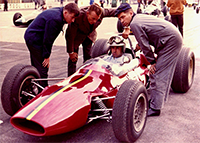 |
Why?
Entering a team into Formula 1 is certainly one of the riskiest steps a manufacturer or a constructor can take. The know-how necessary to establish itself among some of the most powerful sporting entities in the world is a complex matter, which depends on a combination of internal and external factors to succeed. Today, F1 is not just a motorsport category, but a brand that protects itself from any adventurers who could weaken the institution monetarily and sportingly.
However, this process of shielding the category is not something associated with the general history of F1, but instead being a progressive process in the history of the category, which began to take pace at the end of the eighties. Each decade had its cycle of adventurers and pioneers, many of which failed resoundingly in the process of establishing themselves on the Formula 1 scene.
Certainly, one of the decades that contributed most to this myth of F1 being a category that crushes those who fail in it was the 60s. ATS, De Tomaso, Shannon and Scirocco were just some of the names that had short-lived stints in the category, and that contributed to the ever-growing list of Formula 1 fiascos.
One of the most forgotten efforts of that decade was, however, the one undertaken by the brothers Claude and Georges Gachnang, who, in 1965, would found the Scuderia Cegga. Despite the official birth of the team in the middle of the decade, this did not mean that it was only from that point on that both would start to think about F1 – incredible as it may seem, the brothers' involvement with the category had begun at the end of 1961, when the the Scuderia's precursor, ETS Cegga, had been established in partnership by the brothers.
So, let's start this story from the beginning: the team's initial chapter is the end of the fifties, a time when Georges Gachnang began to really get involved with motorsport. In 1960, using an AC Ace Coupé equipped with a 2-litre Bristol engine, the driver participated in his first major international race: the 24h of Le Mans. Teaming up with the famous André Wicky, the eldest brother of the Gachnang family had his first taste of international competitive motorsport as, until now, Georges had only competed in a few hillclimb races in the Alpine region.
This first contact made Georges Gachnang certain that he would firmly pursue his dream of becoming a professional pilot, with his brother Claude as a great supporter. To this end, both joined forces and in October 1960, the brother's first race car was purchased: a 1958 Ferrari 250 TR, which was partially destroyed in a hill climb race in Switzerland.
After undergoing a major overhaul, which partially created a new car over the Testa Rossa chassis, the brothers felt confident to carry out the first tests on the new vehicle at the beginning of 1961. The first official race of the Cegga 002/60 and the now named ETS Cegga team took place in April 1961, in Mauborget. Little was expected from the car, which was the big question mark on the grid. However, driven by Georges himself, the team's first racing vehicle did extremely well, taking second place overall in the event.
This result could be considered beginner's luck for many of those involved in the race – however, this belief was dispelled in the following events in which the Cegga 02/60 participated, with the victory in the traditional St Ursanne-Les Rangiers Hill Climb demonstrating the genius of the brothers in the vehicle project. The duo worked in extreme harmony: Georges was the figure behind the steering wheel, while Claude was responsible for all the mechanical aspects of the squad.
As ETS Cegga's success grew, the brothers began to aspire to new possibilities. As today, the great ambition of a racing car manufacturer in the fifties and sixties was to participate in an international category, to expose its brand and demonstrate its potential compared to other rival constructors. At the pinnacle of motorsport, there is nothing more prestigious and glamorous than Formula 1, the land where motorsport's mythical brands and drivers write their names in the eternity.
It might seem like a giant leap for the Gachnang brothers, jumping from hillclimbs to F1 racing, but in no way this challenge scared the pair. The plan in itself was ambitious for the small team based in the canton of Vaud, but it took on even more dramatic tones with Georges and Claude's decision to build a single-seater from scratch, with the Franc-Swiss driver Maurice Caillet who, influenced by the brothers' recent success in other categories, would be the first customer of the car. They hoped to be the first manufacturers to regularly compete in the category with an all-Swiss team (with chassis and drivers born in the country).
Other teams of Swiss origin, such as Scuderia Platé and Toni Branca, used a mixture of foreign chassis with Swiss drivers, while the only truly Swiss team in the history of Formula 1 till that day, the MBM F1 Team, had contested only two laps of the non-championship 1961 Solitude Grand Prix, before an engine failure spelled the end of the MBM's appearance in category. Although if it weren't for a misfortune (a heavy crash in one of the legs of the Schweizer Meisterschaft, held in Hockenheim at the end of July), this could have been the first Swiss car to compete in an official F1 race, as the vehicle had secured a spot in the German GP, which would be held at the Nürburgring at the beginning of August.
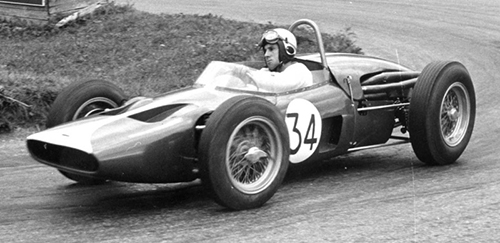
Georges Gachnang during the 1962 Ollon-Villars hillclimb, at the wheel of the original Cegga single-seater, the 01. (credits Gérard Gamand)
Work on the single-seater Cegga then began in mid-1961, with Claude dividing himself between the duties of the team's mechanic, as ETS Cegga's activities could not stop, as a vital source of the team's income for the project came from Georges' success in other races, and designer/builder of the single-seater vehicle. At the end of the year, the Cegga 01 was finally revealed, and, at first glance, the car looked like a hybrid of several F1 and FJ designs. The rear of the car was heavily influenced by the more recent Cooper and Lotus models, while the front of the vehicle looked like the result of a combination between an Emeryson 61 and an Elva 300.
The car was constructed with a spaceframe chassis, and built around a 1.5-litre 4CF2 Maserati engine provided by Caillet, and that was taken from his own modified Lotus XI. The aluminum bodywork was constructed at the famous Carrozzeria Fantuzzi, following the Gachnang's brothers drawings. The big drawback of the Cegga 01 was its weight, almost 50 kilos heavier than the main cars on the grid at the beginning of 1962 (such as the Ferrari 156, which weighed 460kg with full load, and the Lotus 24, which weighed 455kg in the same conditions).
The vehicle's first trial was carried out at the beginning of 1962, when the Cegga 01 was taken to the Autodromo di Modena, undergoing a series of performance evaluation tests under the watchful eyes of the Gachnang brothers. The driver responsible for guiding the 01 on its first adventure on a racetrack was Guerino Bertocchi, an experienced Italian touring driver and one of Maserati's chief mechanics. Although Bertocchi observed some positive signals in the car, overall, the 01 was still far from its ideal, with serious flaws being detected in the suspension system of the car.
Even so, the brothers went ahead, and as the first real test for the new car, a bid was made for an entry into the traditional Grand Prix de Pau, which would be held in 1962 on April 23rd. In the middle of the heavyweight teams who also attended the event, such as Team Lotus, Scuderia Ferrari, BRM and RRC Walker, the ETS Cegga seemed like a dwarf among giants. Claude had gone with the team to the circuit in the heart of the Pyrénées-Atlantiques, while Georges had given his position as the team's main driver in the race to Caillet.
In the first practice sessions, it was clear that the Cegga 01 was ridiculously outpaced by all its rivals. The car was painfully slow in Caillet's hands, both in a straight line and in cornering exit, and despite adjustments made throughout the training day, little had been achieved to improve the car's performance. The best time set by Caillet was around 1.45, 10-15 seconds slower than the best times of the day.
As the session drew to a close, the brothers found themselves in an embarrassing situation - something had to be done. So, Georges quickly changed his clothes in the tracks' locker room, grabbed a helmet and a pair of gloves and sneakily entered the Cegga's cockpit. Georges did three quick laps around the track and, in the best of them, clocked a time of 1.38.4. Despite far from being a spectacular mark, it would be enough to take the vehicle out of last position, even surpassing some of ETS Cegga's national rivals present in Pau, such as Team Lausanne and Ecurie Nationale Suisse.
Although Georges' performance gave encouragement to the Cegga mechanics, demonstrating that they were not to blame for the situation, the driver's attitude only deteriorated the atmosphere within the team. Caillet was extremely embarrassed by Georges' action, which now conveyed the reasons for the car's poor performance to the mediocrity of the driver behind the wheel. Because of this, Caillet refused to continue in Pau, with Claude realizing that it would not contribute anything to the team's image and finances by keeping an operation under this distrust and uncertainty.
Despite the fiasco in their first weekend inside the Formula 1 circus, the Gachnang brothers would not give up so easily. Practically a month later, ETS Cegga entered another non-championship race, the XX Gran Premio di Napoli. For the brothers, it was hoped that this would be the perfect opportunity for the Cegga 01 to have its true baptism of fire, as the Pau race had served only to clearly show some points of improvement for the vehicle, some of which were implemented in the interlude between the two events.
Furthermore, an external factor contributed to the ETS Cegga for that event: unlike the Pau GP, in which the team would have to face its most powerful counterparts in the category, the race in Italy would be a “second tier” event; most of the main Formula 1 teams were at the same weekend at Zandvoort, for the official opening of the 1962 F1 Drivers and Constructors championship. Because of this, in Naples, the only really big team present was Scuderia Ferrari, which divided its efforts between the Dutch and Italian events.
Even with high hopes and an extremely favourable scenario, that weekend's plot seemed like a repeat of Pau's one. Once again Maurice Caillet tried his best to get the most out of the Cegga 01, but that didn't seem enough. The fastest lap recorded by the car was close to a 1.28, slower than vehicles that were generally used to occupying the last positions on the grid, such as the De Tomaso F1 and private-entered Lotus 18s.
Touched once again by his conscience, Claude decided to remove the vehicle's entry even before official training, giving the coup de grâce to the Cegga 01 project in F1. In the following months, Caillet's poor performances began to arouse a certain tone of animosity between the brothers and the driver, with conditions within the team deteriorating considerably since the first heated discussion in Pau. After weeks and months of exchanging accusations, Caillet decided to leave the team, with the 01 returning to the hands of the Gachnang brothers.
Due to this long period of litigation between both parties, the development of the 01 was completely compromised; so, as soon the car arrived in the team's headquarters in Aigle, the brothers chose to reuse the vehicle in the discipline in which ETS Cegga had the greatest success: hill climbing races. And, as incredible as it may seem, it was in this profile that the 01 finally began to blossom: with Georges at the wheel and re-equipped with a 1990cc Maserati engine scavenged from an old Tipo 60, the car began to collect some very interesting results, facing (and beating) in its category several ex-F1 and Formula Junior chassis also adapted to this automotive discipline. The most memorable moment of the vehicle was its overall victory on the 1963 Sierra-Montana-Crans hillclimb, with Georges in command of the machine.
Although the 1962 project was the closest Cegga came to competing in Formula 1, this would not be the Gachnang brothers' last attempt to take a Swiss car to the category. 3 years later, when ETS Cegga had already transformed into the better-known Scuderia Cegga, Claude decided to design a second single-seater, much more conventional than the 01.
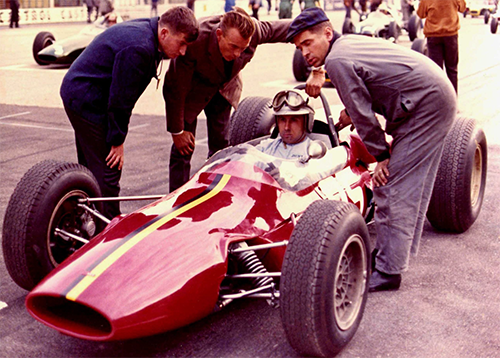
Photo of the Cegga 02, taken during the Monza leg of the 1965 Schweizer Meisterschaft. The driver behind the wheel is Georges Gachnang himself. (credits unknown)
The Cegga 02, presented in 1965, was a spaceframe-type design, with bodywork lines closely resembling those of the Lotus 25. Although initially planned to accommodate the 2-litre Maserati engine again, anticipating the changes to the F1 regulations for 1966, last minute a change of plans made the car being equipped with a 3-litre powerplant donated from a Maserati Tipo 61, with the aim of making the vehicle more competitive in the Swiss national races.
This had to do with the approach taken by the brothers: unlike what they had done in 1962, the Gachnang brothers decided this time to take a more conservative route, choosing to participate in this first cycle of development of the new vehicle only in national events; in particular, those of the Rennwagen class of the Schweizer Meisterschaft, which involved a series of events in the Formula Libre format, counting with traditional, closed circuit races, and hillclimb events.
Although Scuderia Cegga, with the 02, managed to achieve reasonable success with the vehicle throughout the Swiss motorsport season, when 1966 arrived, the team did not make the expected leap into Formula 1. The car was still quite far from the standards imposed by the category, and the second attempt by the Gachnang brothers to try to get into F1 ended before it even really started.
Cegga's history in Formula 1 is similar to that of many small constructors and privateers in F1 in the sixties: entering the category full of enthusiasm and ideas, they soon had their reality check – it took much more than that to achieve any minimal success in the category. Even compared to the pack of midfield teams at this time, such as Reg Parnell, BRP and RRC Walker, few newcomers managed to stand out, with the average life expectancy of a new team in F1 during these years being roughly two years.
Contrasting the first sentence of the paragraph above, the case of ETS/Scuderia Cegga also forms a very interesting chapter of this last amateurish spell of F1: unlike many other new teams and privateers of its time in F1, which revolved around of a more consolidated operation (like Honda, backed by its enormous industrial power) or around more experienced drivers (like ATS, with Phil Hill and Giancarlo Baghetti, or Shannon Racing Cars, with Trevor Taylor), Cegga had none of that at the end of 1961: the team had just completed its second anniversary and was basically a vehicle tuner, not a constructor itself.
This did not stop Georges and Claude from realising their dreams of building single-seater cars for formula racing. Although the Cegga 01 and 02 found little success on formula-related events, their achievements in other motorsport disciplines served as a great testament to the ingenuity of the two brothers.
Unfortunately, the 01 didn't have a very long life as a racing car. In the penultimate stage of the 1963 Schweizer Meisterschaft, the Mitholz-Kandersteg course, Georges Gachnang suffered a serious accident with his vehicle: losing control on one of the curves on the climb, the car went under one of the guard rails, almost decapitating the driver in the process. Luckily, Georges came out with only minor bruises from the crash. The same cannot be said of 01, which was written off. On the other hand, the 02 is deserving of a special mention as the design intended for Scuderia Cegga's return to F1 that never happened. This car remained in use until the late sixties, with Georges Gachnang collecting modest results with the car during its operative years.
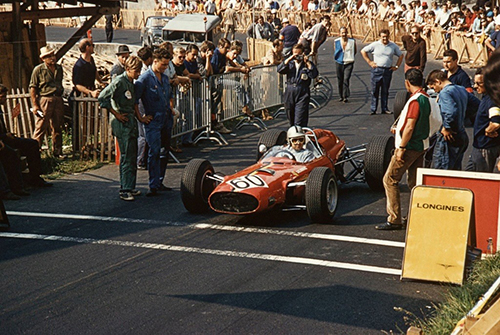
Georges Gachnang at the 1967 Ollon-Villars hillclimb. The car is the Cegga-Ferrari Mk4. (credits Gerard Barathieu)
However, the best results achieved by a Cegga single-seater were not those stipulated by the 01 or 02, but rather, what can be considered the 03 design, which would strangely become better known as the Cegga Mk4. Built over an ex-Filipinetti Lotus 24 chassis (probably the 24-951), the car was immediately equipped with a Ferrari V12 engine taken from a 250 GT. Initially driven by Georges Gachnang in the 1967 Schweizer Meisterschaft, the car went through a half dozen owners until its retirement as a racing car in 1977. Certainly the most illustrious of the drivers who were behind the wheel of the Mk4 (also known as the Cegga-Ferrari V12) was Frenchman Philippe Panis (Olivier's father), who owned the vehicle in 1968.
At the time, the brothers had invested in another ex-F1 chassis, a Cooper - probably the mysterious T80 indicated by renowned researcher David McKinney years ago. Despite this Formula 1 heritage, the Cooper-Cegga was never built with this category in mind. Transformed into a Group 6 prototype, the vehicle was the ultimate representative of the Scuderia Cegga in a territory that the Gachnang brothers knew very well: the peaks of Europe.
Two generations later, Georges' granddaughter Natacha became a racing driver as well, first racing single-seaters in Formula BMW, Star Mazda, Formula 3, Formula 2 and AutoGP before switching to sportscars, where she teamed up with fellow Swiss drivers Cyndie Allemann and Rahel Frey to form an all-female crew for Swiss Matech, racing a Ford GT GT1 car at Le Mans in 2010. A couple of years later she joined her grandfather in a team in the Le Mans Classic to allow this small part of Swiss racing history to come full circle.
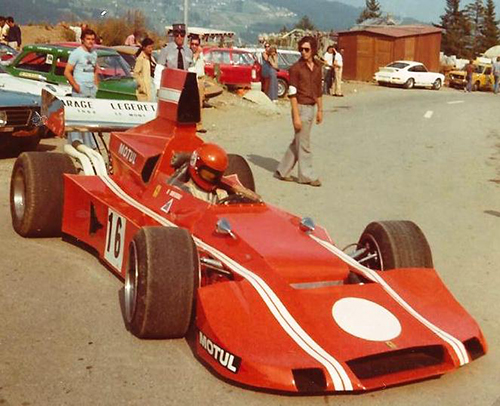
Already unrecognisable after so many modifications, the Cegga-Ferrari Mk4 photographed in the mid-seventies when it already belonged to driver Bernard Gueissaz. (credits unknown)
